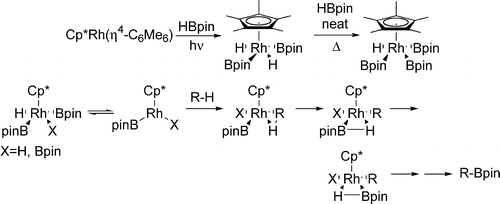Rhodium Boryl Complexes in the Catalytic, Terminal Functionalization of Alkanes

A series of studies have been conducted by experimental and theoretical methods on the synthesis, structures, and reactions of Cp*Rh boryl complexes that are likely intermediates in the rhodium-catalyzed regioselective, terminal functionalization of alkanes. The photochemical reaction of Cp*Rh(η6-C6Me6) with pinacolborane (HBpin) generates the bisboryl complex Cp*Rh(H)2(Bpin)2 (2), which reacts with neat HBpin to generate Cp*Rh(H)(Bpin)3 (3). X-ray diffraction, density functional theory (DFT) calculations, and NMR spectroscopy suggest a weak, but measurable, B−H bonding interaction. Both 2 and 3 dissociate HBpin and coordinate PEt3 or P(p-Tol)3 to generate the conventional rhodium(III) species Cp*Rh(PEt3)(H)(Bpin) (4) and Cp*Rh[P(p-tol)3](Bpin)2 (5). Compounds 2 and 3 also react with alkanes and arenes to form alkyl- and arylboronate esters at temperatures similar to or below those of the catalytic borylation of alkanes and arenes. Further, these compounds were observed directly in catalytic reactions. The enthalpies and free energies for generation of the 16-electron intermediate and for the C−H bond cleavage and B−C bond formation have been calculated with DFT. These results strongly suggest that the C−H bond cleavage process occurs by a metal-assisted σ-bond metathesis mechanism to generate a borane complex that isomerizes if necessary to place the alkyl group cis to the boryl group. This complex with cis boryl and alkyl groups then undergoes B−C bond formation by a second σ-bond metathesis to generate the final functionalized product.
Read more on publisher's site.